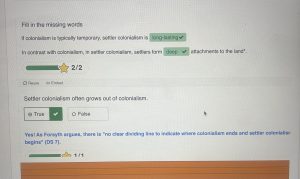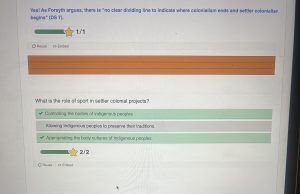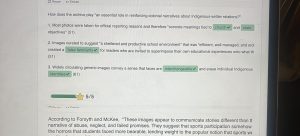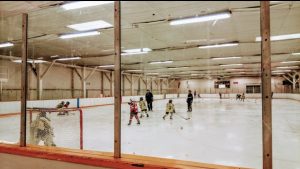4
These are difficult stories. We bear witness in this chapter to the role of sport in furthering the settler colonial projects throughout Turtle Island. Here are some supports to access in the community and from a distance:
First Peoples House of Learning Cultural Support & Counselling
Niijkiwendidaa Anishnaabekwag Services Circle (Counselling & Healing Services for Indigenous Women & their Families) – 1-800-663-2696
Nogojiwanong Friendship Centre (705) 775-0387
Peterborough Community Counselling Resource Centre: (705) 742-4258
Hope for Wellness – Indigenous help line (online chat also available) – 1-855-242-3310
LGBT Youthline: askus@youthline.ca or text (647)694-4275
National Indian Residential School Crisis Line – 1-866-925-4419
Talk4Healing (a culturally-grounded helpline for Indigenous women):1-855-5544-HEAL
Section One: History
A) The Residential School System
Exercise 1: Notebook Prompt
We are asked to honour these stories with open hearts and open minds.
Which part of the chapter stood out to you? What were your feelings as you read it? (50 words)
| Many things stood out to me but what stood out the most in this chapter was the discussion on football and the term “Indianism” discussed on pg. 362. The term was used to suggest that Indigenous knowledge was undesirable. Settler colonial society believed that removing Indigenous identity improved athletic ability and this made me so angry. Heritage does not determine a person’s ability to be successful at a sport. The dehumanizing statements are astonishing here. |
B) Keywords
Exercise 2: Notebook Prompt
Briefly define (point form is fine) one of the keywords in the padlet (may be one that you added yourself).
| Muscular Christianity:
Muscular christianity is an ideology that was created in the mid 19th century by Thomas Hughes and it became popular through his books. This concept is the idea that playing sports builds physical strength, good morals, and makes a person an overall better christian. This concept became very popular in the 1800’s especially in British schools and was instilled upon mostly men, because playing sports allowed boys to assert their manliness and become “manly”. An example of this ideology could be seen through the sport of rugby. I have learned in other realms of life that rugby was often encouraged in British colonies because it proved one’s manliness and promoted discipline, strength, and determination. It is important to mention that this concept of Muscular christianity was used to further assimilate Indigenous boys and men as it forced them to prove themselves through physical education and sports.
|
C) Settler Colonialism
Exercise 3: Complete the Activities


Exercise 4: Notebook Prompt
Although we have discussed in this module how the colonial project sought to suppress Indigenous cultures, it is important to note that it also appropriates and adapts Indigenous cultures and “body movement practices” (75) as part of a larger endeavour to “make settlers Indigenous” (75).
What does this look like? (write 2 or 3 sentences)
| This process can be seen in how settlers appropriate Indigenous sports and body movement practices while erasing their original cultural significance. For example, lacrosse, which holds deep spiritual and cultural meaning for many Indigenous nations was taken and rebranded as a Canadian national sport making it less-Indigenous. Similarly, colonialism suppressed Indigenous dances and body movement practices while selectively incorporating elements of them into settler colonial spaces. This practice reinforces settler identity whilst marginalizing Indigenous peoples.
|
D) The Colonial Archive

Exercise 5: Complete the Activities
Section Two: Reconciliation
A) Reconciliation?
Exercise 6: Activity and Notebook Prompt
Visit the story called “The Skate” for an in-depth exploration of sport in the residential school system. At the bottom of the page you will see four questions to which you may respond by tweet, facebook message, or email:
How much freedom did you have to play as a child?
What values do we learn from different sports and games?
When residential staff took photos, what impression did they try to create?
Answer one of these questions (drawing on what you have learned in section one of this module or prior reading) and record it in your Notebook.
| When residential staff took photos, what impression did they try to create?
When residential school staff took photos, they were aiming to create a positive impression that would make society believe these residential schools were fun, enriching places for Indigenous children to learn. However in reality it is important to mention that residential schools hid horrific abuse and cultural assimilation behind their walls. The story Skate mentions that photographs of children playing hockey were circulated to demonstrate the school’s success in forcing Indigenous children to accept colonial ways of life. A person named Eugene states: “The missionaries used us. The missionaries liked to show off these kids from the residential school.” This shows that photos were used to create an impression that lied about the true nature of residential schools and allowed them to hide behind a facade of positivity. The story also mentions that even today these images are often misinterpreted as proof that residential schools provided a safe and enjoyable environment for Indigenous children. To back this point up other sources explain that residential schools were always trying to create a good impression for themselves. Chapter 15 by Chief Justice Murray Sinclair et al., explains that residential schools often promoted extracurricular activities such as band and a cadet corps to improve their overall public image (Sinclair, 2015). It is explained that these activities were often used to present a misleading impression that made residential schools look better than they truly were. This example here proves that residential schools were always aiming to create a good impression that promoted themselves as inclusive and fun, covering up their negative aspects. In my knowledge photos have always been used to deceive people and that is exactly what they are being used for in this situation. Photos were used to create an impression that promoted residential schools so that nobody would ever find out what they were hiding.
|
B) Redefining Sport
B) Sport as Medicine
Exercise 7: Notebook Prompt
Make note of the many ways sport is considered medicine by the people interviewed in this video.
| First off sports serve as medicine because they help Indigenous people reclaim their identities. Through sports Indigenous people are able to reclaim and celebrate their traditional knowledge. For example in the video it is mentioned that sport allowed these people to speak their native language which helped them reclaim who they are as Indigenous people. This made them proud and helped to contribute to cultural resurgence which is a source of medicine for Indigenous populations.
Next, sports serve as medicine because they are central to progressive well-being. Participation in sports promotes physical well-being and serves as almost a type of therapy for mental health struggles. As one of the girls states in the video, sport helped her go through school because it gave a sense of relief. Sports offer unique ways to cope with stress, intergenerational trauma and other physical and psychological issues prevalent in many Indigenous communities therefore it can be seen as a type of medicine. To go along with this, sports serve as medicine through initiating cultural connection. Like the video explains Sport, particularly traditional games like lacrosse are often viewed as a gift from the Creator which shows how sports can have tremendous cultural significance that reinforce Indigenous identity. If Indigenous people come together to play sports they can heal lost connections to each other and their creator. From my understanding Indigenous knowledge focuses on healing the mind body and spirit and this video proves that sport is a Holistic form of medicine that supports the mind body and spirit in incredibly unique ways.
|
C) Sport For development
Exercise 7: Notebook Prompt
What does Waneek Horn-Miller mean when she says that the government is “trying but still approaching Indigenous sport development in a very colonial way”?
| When Waneek Horn-Miller says that the government is trying but still approaching Indigenous sport development in a very colonial way I think she simply means that the government can’t seem to shake its colonial attitude. When she says this she is referring to the notion that while there are a plethora of efforts being made by society to improve Indigenous sports, the government’s efforts are still highly shaped by colonial perspectives and attitudes. One way this manifests is through lack of cultural sensitivity. Government-led initiatives do not always incorporate Indigenous practices, values, or traditions into sports development which hinders Indigenous people’s ability to fully feel welcome in the sporting realm. To go along with this the government tries to include Indigenous people but often fails. Although there is some attention to Indigenous people in sport they are never given the same recognition or opportunities as people who are not Indigenous. An example of this is the underrepresentation of Indigenous people in the olympics. One final example I have spoken about in previous courses in Indigenous studies is the government’s top-down approach to inclusion.This top-down approach excludes Indigenous people from decision making and does not allow them to have a say in any policy that shapes sports for them. This approach neglects their voices and is truly missing the whole point of Including Indigenous populations. In all I think that Waneek Horn-Miller is explaining that there is a small effort being made by the government to help Indigenous sport development but they have yet to fully understand what needs to be done to create progress in a truly meaningful way. As she says the government is “trying” but they have yet to ensure that Indigenous populations maintain Indigenous autonomy and receive equal inclusion in sports. |
Exercise 8: Padlet Prompt
Add an image or brief comment reflecting some of “binding cultural symbols that constitute Canadian hockey discourse in Canada.” Record your responses in your Notebook as well.
|
There are so many symbols that connect to hockey and Canadian nationalism that it is hard to choose just one to talk about. I chose a photo of an older small town rink Called Northcrest Arena which used to be here in Peterborough. Just the symbol of a small town rink captures the essence of Canadian hockey and its national meaning. The symbol of a small town rink is so powerful because it represents the grassroots of the sport. These rinks are where generations and generations of players have learned to skate, compete, and dream of making it to the OHL, or NHL. I myself learned to play hockey in this particular arena therefore I think small town rinks embody the heart of Canadian hockey culture and its community. Everyone in the town always gathers at these rinks and the image evokes nostalgia for many people because small town rinks are a shared national experience. Adding to this, The Hockey Song by Stompin’ Tom Connors is another powerful cultural symbol. Played at nearly every Canadian hockey game, its lyrics celebrate the game and reinforce hockey as more than just a sport. The song explains that hockey is a shared national tradition. This song unites people across generations and backgrounds, much like the small-town rinks that form the foundation of Canadian hockey culture. Together, these symbols capture the heart of the game and its deep connection to Canadian identity. I do want to mention however that these binding symbols are oftentimes westernized and they don’t always consider the lives of Indigenous peoples or communities. |
Section Three: Decolonization
Please see the major assignment for this half of the term in the final section of this chapter.
Longer Prompt: Read the TRC’s 94 Calls to Action specific to sport again. Choose one of the Calls to Action that have been answered in full or in part and in 300 words explain the steps that have been taken to fulfill them and provide specific examples of what this looks like. Also reflect on how communities and individuals (particularly settlers) can contribute to addressing these Calls to Action.
For the purpose of this question I chose to talk about Call to Action 87 which calls on all levels of government, in collaboration with Aboriginal peoples and sports organizations, to provide public education that tells the national story of Aboriginal athletes in history. (Government of Canada, 2024). This Call to Action has seen meaningful progress in several ways but I think there is still more work to be done to ensure it is fully fulfilled. This first step that has been taken that is crucial for this progress are budgets and funding. These initiatives have been backed by consistent federal funding. The budget in 2017 invested $18.9 million over 5 years, with ongoing support, and the budget 2022 added another $20 million over 5 years (Government of Canada, 2024). This funding is a great first step to fulfilling this call to action because this money allows people to make change. A very significant example of progress is the Tom Longboat Awards. These awards have been recognizing outstanding Indigenous athletes in Canada since 1951. Since 1999, these awards have been managed by the Aboriginal Sport Circle and more recently they were relaunched and they became partners with Canada’s sports hall of fame to ensure ongoing recognition of Indigenous athletes in Canada (Government of Canada, 2024). Another step that has been taken are the National Indigenous Coaching Awards. These awards are now presented annually at the Petro-Canada sport leadership Gala to recognize Indigenous coaches who are making a difference in the sporting world (Government of Canada, 2024).
This Call to Action is especially important because the awards are not only just symbolic but they serve as educational tools that help dismantle systemic racism in the sporting world. This is important because it influenced the way I thought of how settlers and non-Indigenous people could contribute to addressing this call to action. I believe that there are a plethora of things that settlers and non-Indigenous communities can do to help advance Call to Action number 87 but education is the most important tool. First off, I think settlers and non-Indigenous people should learn about and share stories of Indigenous athletes. They should do this by advocating for their inclusion in education. School curriculums should teach about Indigenous athletes achievements and make people aware that they too can play sports and contribute to them in a meaningful manner. I also think that coaches of all sports teams should be sharing stories of Indigenous athletes. By doing this they can make the younger generation aware of Indigenous athletes and help combat lasting stereotypes that Indigenous people cannot be role models in sport. By sharing these stories non-Indigenous people can contribute to reconciliation and help create a more inclusive understanding of Canada’s sports history. By helping to educate general society non-Indigenous people can dismantle racist ideas of Indigenous people in sports.
Reference
Government of Canada; Crown-Indigenous Relations and Northern Affairs Canada. (2024). Sports and reconciliation. https://www.rcaanc-cirnac.gc.ca/eng/1524505883755/1557512006268



Feedback/Errata